
Phyllurus is a small genus of Australian leaf-tailed geckos, lizards in the family Carphodactylidae. Rarely seen outside their native habitat, they are notable for their highly effective camouflage which is in part aided by the spiny tubercles that cover every body part.
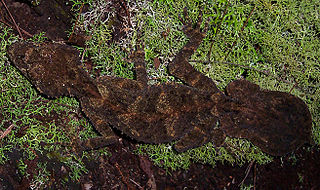
Saltuarius is a genus of larger Australian geckos, known collectively as leaf-tailed geckos.

Saltuarius swaini, also known as the southern leaf-tailed gecko or Border Ranges leaf-tailed gecko is endemic to Australia where it is found in coastal mountain ranges of southeastern Queensland and northern New South Wales. It inhabits rainforests and lives inside large tree root systems and hollows of strangler figs. Its scientific name is after Malcolm Swain of the NSW National Parks & Wildlife Service.
Uvidicolus is a monotypic genus of lizard in the family Carphodactylidae. The genus contains the sole species Uvidicolus sphyrurus, also known commonly as the border thick-tailed gecko. The species is endemic to Australia.
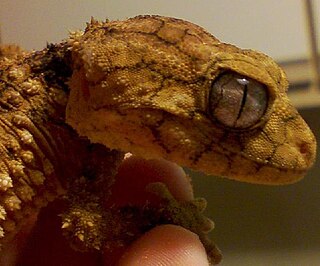
Nephrurus amyae, also known commonly as the Centralian rough knob-tail gecko, is a species of lizard in the family Carphodactylidae. It is the largest gecko in the genus Nephrurus, and like all species of Nephrurus is endemic to Australia.
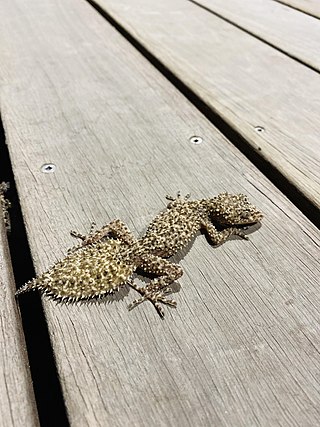
The broad-tailed gecko, southern leaf-tailed gecko, or Sydney leaf-tailed gecko is a common gecko of the family Carphodactylidae found in the Sydney Basin. The species uses its mottled colour to camouflage against bark or rock, and if threatened can drop its large fleshy tail as a decoy. The tail is also useful for fat storage. This species of gecko is available in captivity as a pet, they are a nocturnal ambush hunter, relying on camouflage and patience to catch prey. Primary prey items include large nocturnal invertebrates such as spiders, cockroaches and beetles.
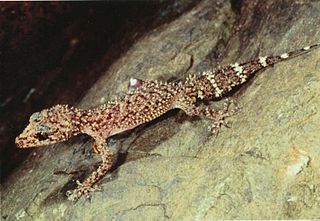
Champion's leaf-tailed gecko, also known commonly as the Koumala leaf-tailed gecko, is a species of gecko, a lizard in the family Carphodactylidae. The species is endemic to Australia.

The northern spiny-tailed gecko is a species of lizard in the family Diplodactylidae. The species is endemic to Australia.
Lucasium byrnei, also known commonly as the gibber gecko, Byrne's gecko, and the pink-blotched gecko, is a species of small, nocturnal lizard in the family Diplodactylidae. The species is endemic to Australia.

The northern leaf-tailed gecko is a species of the genus Saltuarius, the Australian leaf-tailed geckos.
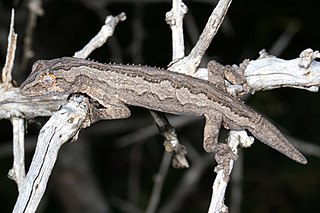
Strophurus intermedius, also known commonly as the eastern spiny-tailed gecko or the southern spiny-tailed gecko, is a species of lizard in the family Diplodactylidae. The species is endemic to semi-arid regions of Australia in New South Wales, Northern Territory, South Australia, Victoria and Western Australia, in mallee shrubland and woodland habitats.
Orraya is a monotypic genus of lizard in the family Carphodactylidae. The genus contains the sole species Orraya occultus, also known commonly as the McIlwraith leaf-tailed gecko or the long-necked northern leaf-tailed gecko. The species is endemic to Australia.
Phyllurus isis, also known commonly as the Mount Blackwood leaf-tailed gecko and the Mount Jukes broad-tailed gecko, is a species of gecko, a lizard in the family Carphodactylidae. The species is endemic to Mount Blackwood and Mount Jukes in mideastern Queensland, Australia.

Phyllurus nepthys, also known commonly as the Eungella leaf-tailed gecko, is a species of lizard in the family Carphodactylidae. The species is endemic to Australia.
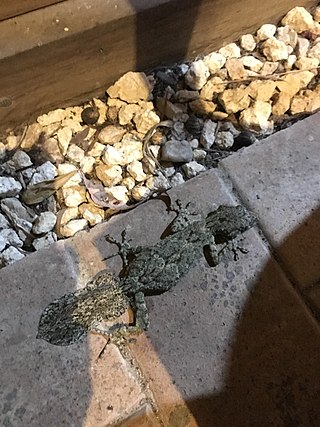
Saltuarius moritzi, also known commonly as the New England leaf-tailed gecko or Moritz's leaf-tailed gecko, is a species of lizard in the family Carphodactylidae. The species is native to Australia.

Saltuarius salebrosus, also known as the rough-throated leaf-tailed gecko or Central Queensland leaf-tailed gecko, is a gecko found in Australia. It is endemic to dry areas in mid-eastern and south-central Queensland.

Amalosia jacovae, also known commonly as the clouded gecko or the clouded velvet gecko, is a species of lizard in the family Diplodactylidae. The species is endemic to Australia.
The Goldfields spiny-tailed gecko is a species of lizard in the family Diplodactylidae. The species is endemic to Australia.

Strophurus taenicauda, also known commonly as the golden spiny-tailed gecko or the golden-tailed gecko, is a species of lizard in the family Diplodactylidae. The species is endemic to eastern Australia. Three subspecies are recognized.
Cyrtodactylus hoskini is a species of gecko, a lizard in the family Gekkonidae. The species is endemic to Australia.













